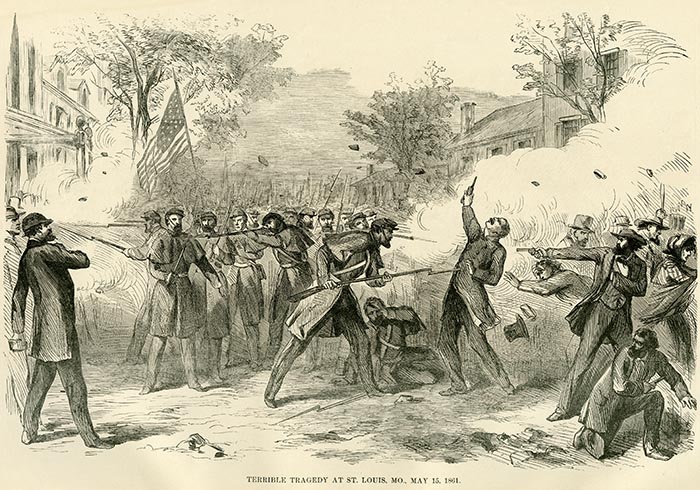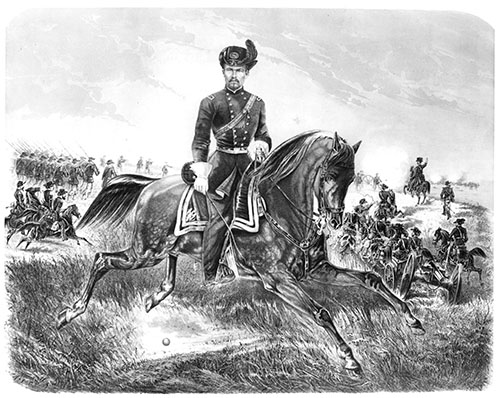
Franz Sigel
Franz Sigel was a Union general in the Civil War. He was born on November 18, 1824, in Sinsheim, a small community in southwest Germany, and was the third of six children of Moritz Sigel, a lawyer and judge, and his wife, Anna Marie Pauline Lichtenauer. Franz received an excellent education at the Classical School in Bruchsal and the military academy at Karlsruhe. He served as a lieutenant in the Baden army from 1843 to 1847, but resigned after killing another officer in duel.
Sigel entered law school at the University of Heidelberg, but the Revolutions of 1848 began soon after he enrolled. Sigel led a group of inexperienced soldiers against the monarchy in Baden and was defeated. He returned in 1849, serving as revolutionary commander-in-chief and secretary of war, but was defeated again. He fled Germany forever on July 7, 1849.
Sigel bounced around Europe before moving to London, where he initially made a living as a pianist. In 1852 he immigrated to New York City, where he worked a variety of jobs, including being a language tutor, musician, surveyor, cigar store owner, author, magazine publisher, and teacher. In 1854 Sigel married Elsie Dulon, with whom he had five children. In 1857 he moved to St. Louis, where he joined the Republican Party, cofounded a monthly magazine, and was a teacher and superintendent at the German Institute.
Sigel resigned from the German Institute in February 1861 to fight in the Civil War. He was appointed second lieutenant, then colonel, in a local Union army regiment in St. Louis. Sigel was extremely popular with German Americans for his past military activities in Germany. Many German volunteers who joined the Union army proudly said, “I fights mit Sigel.”
Sigel served under General Nathaniel Lyon in St. Louis and took part in the Camp Jackson Affair on May 10, 1861. He was promoted to brigadier commander in the Second Brigade of the Missouri Volunteers and went to Springfield to stop Confederate armies from joining together. Sigel unknowingly freed captured Confederate spies, who betrayed his position. Falsely thinking he had the advantage, Sigel marched his forces on Carthage, Missouri, on July 5 against a much larger Confederate force. After several cannons overheated, Sigel’s men retreated. His effective tactics kept the enemy from overwhelming his smaller force. This increased his legend among the German Americans.
Sigel’s forces regrouped with Lyon’s in Springfield. On August 10, at the Battle of Wilson’s Creek, Sigel led a failed attempt to surround the larger Southern forces of General Sterling Price. Lyon was killed and Sigel again led a retreat. His performance in this retreat drew criticism from soldiers until Major Samuel Sturgis took command. Despite this failure, Sigel was promoted to brigadier general on August 28.
Offended that Brigadier General Henry Halleck did not promote him to an even higher position, Sigel resigned on December 31, 1861. German Americans across the nation protested. President Lincoln refused to accept his resignation, and Sigel kept his position. His greatest victory came in March 1862 at the Battle of Pea Ridge in northwest Arkansas, where Sigel’s troops forced the Confederate army to flee in panic. Afterward, Sigel was promoted to major general and sent to fight in the East, where he chose mainly German Americans such as Carl Schurz to serve as his officers.
In June Sigel was given command of the First Corps in the massive Army of Virginia, which was disbanded after suffering a defeat at the Second Battle of Bull Run. Sigel was then given a smaller command with the Eleventh Corps of the Army of the Potomac in January 1863. Constantly at odds with Union leadership, Sigel asked to be relieved of his command in March. In April he asked to be reinstated and was given a relatively unimportant post in a reserve army in Pennsylvania.
Sigel was given command of the Department of West Virginia on February 2, 1864, but was relieved in May after suffering a defeat at the Battle of New Market. Sigel then led a reserve force charged with protecting Harpers Ferry and the Baltimore and Ohio Railroad, but performed poorly and was relieved for a final time on July 8, 1864. On May 4, 1865, Sigel resigned from the Union army.
After the war, Sigel published a German-language newspaper in Baltimore before going to New York City in 1867. After short stints as a draftsman in two transportation companies, he served in a number of local government positions from 1870 to 1889, including internal revenue collector, city register, equity clerk in the county clerk’s office, and pension agent. He was also a writer, public speaker, and school district inspector. In 1895 he published a newspaper, the New Yorker Deutches Volksblatt. He was editor of the New York Monthly from 1897 until his retirement in 1900.
After years of declining health, Franz Sigel died on August 21, 1902. Ever popular among German Americans, Sigel’s visitation was attended by over twenty-five thousand people. Schools, parks, and ships were named after him, and statues were erected in St. Louis and New York. Although Sigel ultimately failed as a general, his celebrity status inspired many German Americans to support the Union cause.
Text and research by Todd Barnett
References and Resources
For more information about Franz Sigel’s life and career, see the following resources:
Society Resources
The following is a selected list of books, articles, and manuscripts about Franz Sigel in the research centers of The State Historical Society of Missouri. The Society’s call numbers follow the citations in brackets.
Articles from the Missouri Historical Review
- “Battle of Wilson’s Creek. Letter of Gen. F. Sigel.” v. 1, no. 2 (January 1907), pp. 147–148.
- Giffen, Lawrence E. “The Strange Story of Major General Franz Sigel: Leader and Retreater.” v. 84, no. 4 (July 1990), pp. 404–427.
- Sigel, Franz. “The Military Operations in Missouri in the Summer and Autumn of 1861.” v. 26, no. 4 (July 1932), pp. 354–367.
Articles from the Newspaper Collection
- “Funeral of Gen. Sigel.” Hermann Advertiser-Courier. August 27, 1902. p. 1, c. 7. [Reel # 13878]
- “Gen. Franz Sigel Famous Soldier Dies at New York.” St. Louis Post-Dispatch. August 21, 1902. p. 11. [Reel # 41876]
- “General Franz Sigel Returned to This City Yesterday.” Daily Missouri Republican. May 18, 1863. p. 1, c. 3. [Reel # 41398]
- “‘Mit Sigel:’ Gen. Franz Sigel Revisits St. Louis after Sixteen Years’ Absence.” St. Louis Post-Dispatch. February 13, 1879. p. 1. [Reel # 41759]
- “Sigel Monument Unveiled in Park: Heroic Statue of General Presented to City by German-Americans.” St. Louis Post-Dispatch. June 24, 1906. p. A10. [Reel # 41910]
Books and Articles
- Balmer, Charles. General Sigel’s Grand March: Composed and Respectfully Dedicated to Brigadier General Franz Sigel by Henry Werner. St. Louis: Balmer and Weber, 1861. [REF MUSIC W495g]
- Christensen, Lawrence O., William E. Foley, Gary R. Kremer, and Kenneth H. Winn, eds. Dictionary of Missouri Biography. Columbia: University of Missouri Press, 1999. pp. 699–700. [REF F508 D561]
- Engle, Stephen Douglas. Yankee Dutchman: The Life of Franz Sigel. Fayetteville: University of Arkansas Press, 1993. [REF F508.1 Si22e]
- Hess, Earl J. “Sigel’s Resignation: A Study in German-Americans and the Civil War.” Civil War History. v. 26, no. 1 (March 1980), pp. 5–17.
- Hess, Earl J., Richard W. Hatcher III, William Garrett Piston, and William L. Shea. Wilson’s Creek, Pea Ridge, and Prairie Grove: A Battlefield Guide with a Section on the Wire Road. Lincoln: University of Nebraska Press, 2006. [REF F554.1 H463]
- “McCullogh Has Made a Clean Plate in Missouri.” Gateway Heritage. v. 14, no. 1 (Summer 1993), pp. 4–25. [REF F550 M69gh]
- “Military Rulers of Springfield.” Springfield! Magazine. v. 14, no. 1 (June 1992), pp. 28–29, 51. [REF H268.04 Sp84sm]
- Piston, William Garrett, and Richard W. Hatcher III. Wilson’s Creek: The Second Battle of the Civil War and the Men Who Fought It. Chapel Hill: University of North Carolina Press, 2000. [REF F554.1 P678]
- Warner, Ezra J. Generals in Blue: Lives of the Union Commanders. Baton Rouge: Louisiana State University Press, 1986. [REF 973.741 W243]
Manuscript Collection
- Buegel, John T., Civil War Diary, 1861-1864 (C1844)
The collection contains a diary, in German, with translation by William G. Bek, 1945. The diary documents Buegel’s career as a soldier in Company F, 3rd Regiment, Missouri Volunteer Infantry during the Civil War, including the battles of Camp Jackson, Wilson’s Creek and Springfield, and Sherman’s march to the sea. Sigel is mentioned in folder 2. - Filley, Augustus and Samuel R., Papers, 1817-1879 (C3468)
Folder 2 includes correspondence of Samuel R. Filley regarding payment of military officers and soldiers, a Union loyalty oath form and money solicitation for Union volunteers, and Confederate authorization for a Missouri and Trans-Mississippi ranger company. Sigel is mentioned in a letter to James B. Fry regarding conscription. - Mit Fedr Und Hamer! (With Feather and Hammer): The German Experience in St. Louis Records (S0941)
This collection contains photographs used in the exhibit Mit Feder und Hamer! (With Feather and Hammer): The German Experience in St. Louis, held in St. Louis in 1983 and in the Federal Republic of Germany (West Germany) from 1984 to 1989. Box 1, folder 37 contains an image titled “Sigel’s Regiment of Home Guard under Attack” dated May 11, 1861. Folder 91 contains a portrait of Sigel. Box 5, folder 161 contains an image of the General Franz Sigel Monument in Forest Park. - “A Short Sketch of My Experiences During the First Stages of the Civil War,” R.C. Carter (C2911)
The collection contains a memoir describing the experiences of a Confederate lieutenant. He includes the battles of the Hemp Bales, Wilson’s Creek, Pea Ridge, and Boonville in his reminiscences. - Voelkner, Henry, Letters, 1861-1862 (C0436)
Letters written in German by a Union soldier fighting in Missouri during the Civil War, including description of the battle of Sugar Creek, with typed translations. Franz Sigel is mentioned in folders 1 and 2.
Outside Resources
- American Battlefied Trust: Battle of Wilson’s Creek
This website describes the Battle of Wilson’s Creek. - Community & Conflict: The Impact of the Civil War in the Ozarks
This digital collection contains Civil War documents pertaining to the Ozarks region. The website was created through a partnership of several organizations, including the Springfield-Greene County Library District. It contains scans of the State Historical Society’s Lyman Gibson Bennett Collection. Sigel is mentioned in several diary entries dated between November 20, 1861 and March 8, 1862. - Wilson’s Creek National Battlefield
This U.S. National Park Service website provides information for visiting the site of the Battle of Wilson’s Creek.



